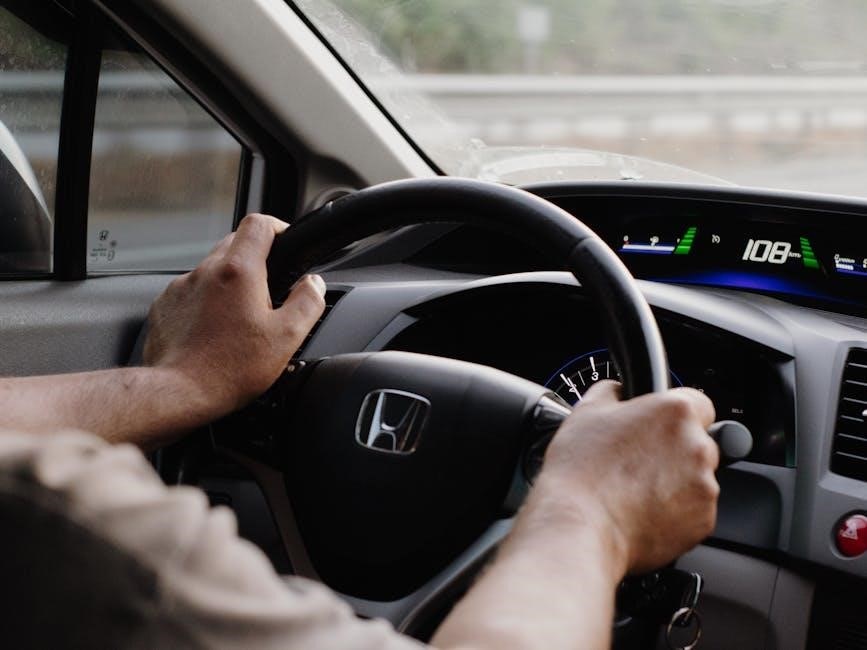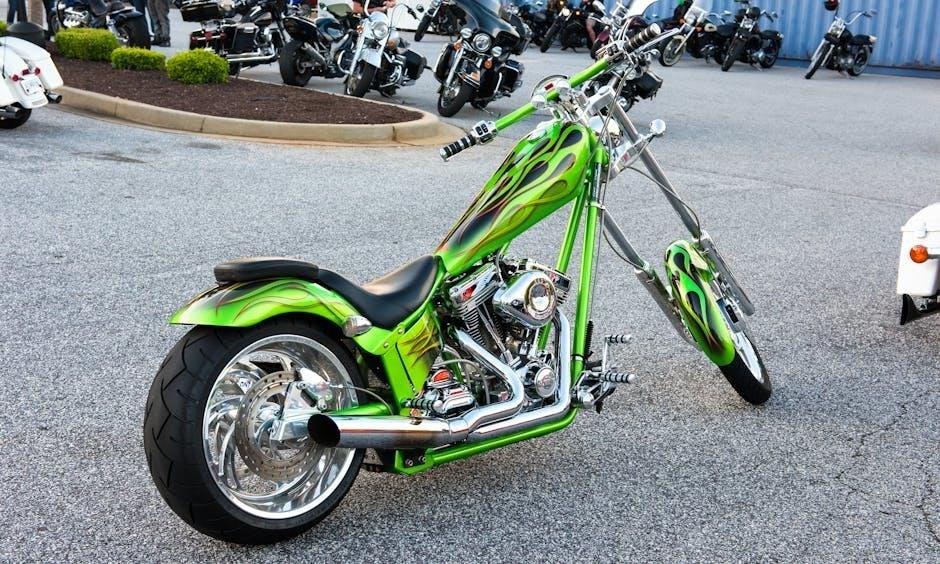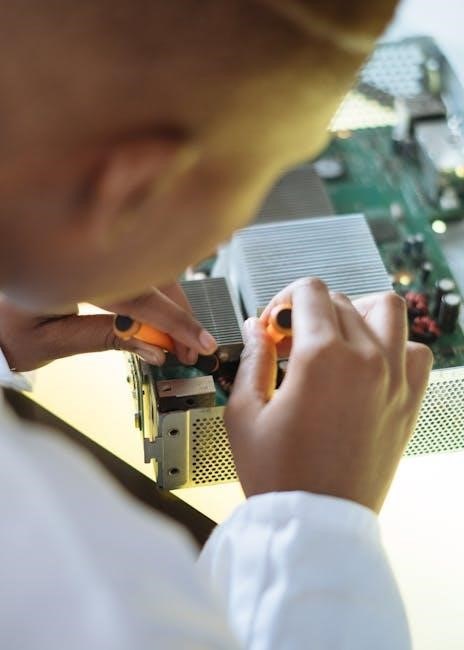cj1000dxt manual
CAT CJ1000DXT Jump Starter⁚ A Comprehensive Guide
This manual provides a complete guide to safely operating and maintaining your CAT CJ1000DXT jump starter, power station, and air compressor. It covers charging, jump-starting procedures, using the AC/DC power supplies, and USB ports, plus troubleshooting and maintenance.
Safety Precautions and Warnings
Before using the CAT CJ1000DXT, carefully read all instructions in this manual. Always wear safety glasses to protect your eyes from potential debris or sparks. Ensure the unit is fully charged before each use. Never attempt to jump-start a vehicle with a damaged battery or in an unsafe environment. Avoid contact with moving parts during operation. Keep the unit away from flammable materials and open flames. Do not use the air compressor to inflate tires beyond their recommended pressure. Always disconnect the jump starter clamps from the vehicle battery before turning off the unit. Never touch the clamps while the unit is operating. If the unit becomes hot to the touch, immediately discontinue use and allow it to cool. Consult a qualified technician for any repairs or modifications. Improper use can result in injury or damage to the unit. Follow all local safety regulations and guidelines when operating the CJ1000DXT.
Charging and Recharging the CJ1000DXT
The CAT CJ1000DXT jump starter requires a full 40-hour initial charge upon receipt, as the internal battery ships partially charged. Use only the provided charging cable and adapter. Connect the cable securely to the unit and a suitable power outlet. The charging indicator light will illuminate, indicating charging progress. A fully charged unit will show a solid indicator light; charging time may vary depending on the remaining battery charge. Avoid overcharging, as this could damage the battery. Regularly charge the unit after each use to maintain optimal performance. For prolonged storage, fully charge the unit and store it in a cool, dry place away from extreme temperatures. The recommended charging frequency depends on usage; however, it’s best to fully recharge the unit after each use, or at least once a month if not frequently used. Never leave the unit unattended while charging. If the charging indicator light malfunctions, refer to the troubleshooting section of this manual or contact customer support.
Jump Starting Procedures
Before attempting to jump-start a vehicle, ensure the CJ1000DXT is fully charged and review the vehicle’s owner’s manual for specific jump-starting instructions. Turn off all accessories in the vehicle requiring power. Identify the positive (+) and negative (-) terminals on the vehicle’s battery. Connect the red (positive) clamp to the vehicle’s positive (+) terminal, then connect the black (negative) clamp to an unpainted metal surface away from the battery. Avoid touching the clamps together or allowing them to touch any other metal surfaces. Turn the CJ1000DXT power switch to the ON position. Attempt to start the vehicle. If the vehicle starts, remove the clamps in reverse order—negative first, then positive. If the vehicle fails to start, double-check the connections and try again, but limit attempts to prevent overheating. Never attempt to jump-start a vehicle with a severely damaged or corroded battery. Consult a qualified mechanic for assistance. In case of any difficulty or uncertainty, refer to the troubleshooting section of this manual or contact customer support for assistance.
Using the 120V AC Portable Power Supply
The CAT CJ1000DXT features a built-in 200-watt power inverter providing convenient 120V AC power. Before use, ensure the unit is adequately charged. Locate the 120V AC outlet on the device. Plug your device’s power cord firmly into this outlet. The maximum power output is 200 watts; exceeding this may overload the inverter. Avoid using high-wattage appliances that may draw more than the rated power; If you are unsure about the power requirements of your device, check its specifications. Do not operate the inverter with the unit’s battery at a low level to prevent damage. Monitor the battery level indicator to ensure adequate power remains. Always unplug your device from the inverter before disconnecting the inverter from the power station. Regular inspection of the AC outlet for any damage or debris is recommended. If any issues occur during operation, refer to the troubleshooting section of this manual or contact customer support for assistance. Safe and proper usage ensures optimal performance and longevity of your CJ1000DXT.
Utilizing the USB Power Ports
The CAT CJ1000DXT boasts four convenient 2-amp USB charging ports for simultaneously powering multiple devices. Before connecting your devices, ensure the jump starter is adequately charged. Locate the four USB ports on the unit’s exterior. Connect your USB devices, such as smartphones, tablets, or other compatible electronics, to the ports. Each port provides a 2-amp output, allowing for efficient and rapid charging. The integrated safety circuitry prevents overcharging and protects your devices from damage. Avoid using damaged or incompatible USB cables to prevent malfunctions. For optimal performance, use high-quality cables designed for efficient charging. Do not attempt to charge devices exceeding the 2-amp capacity of the ports; this may lead to slower charging or potential damage. Regularly inspect the USB ports for any signs of damage or debris. If any issues arise during charging, consult the troubleshooting section of this manual or contact customer support. Proper usage of the USB ports ensures prolonged device lifespan and reliable charging capabilities.
Operating the 12V DC Portable Power Supply
The CAT CJ1000DXT includes a 12V DC portable power supply outlet, perfect for powering various 12V DC devices. Before use, ensure the jump starter is sufficiently charged and the 12V DC outlet is clean and free from debris. Identify the 12V DC output port on the unit. Connect your compatible 12V device using the appropriate connector. Ensure the connector is securely attached to both the device and the outlet to avoid power loss or damage. Turn on your 12V device and monitor its operation. The 12V DC output provides a consistent power supply for compatible devices. Do not use the 12V DC outlet with devices exceeding its voltage and amperage capacity; exceeding the limits may damage the jump starter or the connected device. If the connected device malfunctions, disconnect it immediately and inspect for any damage. Always consult the device’s user manual for specific operating instructions and compatibility. Regularly inspect the 12V DC outlet for any signs of damage or wear. If you notice any issues, cease operation and contact customer support for assistance. Proper use ensures optimal performance and safety.
Maintaining the Air Compressor
Regular maintenance of the CAT CJ1000DXT’s integrated air compressor ensures optimal performance and longevity. After each use, carefully clean the compressor nozzle and surrounding areas, removing any dirt, debris, or moisture. Inspect the air hose for any signs of damage, cracks, or wear. Replace the hose immediately if damage is detected to prevent leaks or malfunctions. Periodically check the air filter for blockages or dirt accumulation. A clogged filter reduces air flow and compressor efficiency. Clean or replace the filter according to the manufacturer’s recommendations. Store the compressor in a cool, dry place, away from direct sunlight and extreme temperatures. Avoid storing the unit with the hose tightly coiled or kinked, as this can damage the hose over time. Before each use, perform a quick visual inspection of the compressor for any visible damage or loose parts. Address any concerns before operating the device. Lubricate the compressor’s moving parts as needed, using only the recommended lubricant specified in the owner’s manual. Never attempt to repair the compressor yourself unless you have the necessary expertise. If any issues arise, contact customer support or a qualified technician for assistance.
Troubleshooting Common Issues
If the CAT CJ1000DXT jump starter fails to power on, ensure it’s fully charged. Check the power switch and connections. If the problem persists, consult the manual’s troubleshooting section or contact customer support. Should the jump starter fail to start a vehicle, verify the battery clamps are correctly attached to the vehicle’s battery terminals, observing correct polarity (+ to +, ‒ to -). Inspect the vehicle’s battery for sufficient charge; a weak battery might require charging before jump-starting. If the air compressor doesn’t inflate, check if the air hose is securely connected and free of kinks or blockages. Inspect the nozzle for obstructions and ensure the pressure is properly set. If the 120V AC outlet fails to function, ensure the unit is fully charged and the power switch is on. Check the outlet itself for any damage. For USB charging issues, verify that the USB ports are functioning correctly and the connected device is compatible. If the 12V DC outlet is not working, confirm the power switch is activated and the connections are secure. If problems persist after trying these steps, refer to the detailed troubleshooting section within the complete user manual or contact Caterpillar customer support for further assistance. Remember to never attempt internal repairs yourself; always seek professional help for complex issues.
Specifications and Technical Details
The CAT CJ1000DXT boasts a peak amperage of 1200 amps, providing ample power for jump-starting most 12V vehicles, including larger engines. Its instant starting amps are rated at 500 amps, ensuring a quick and reliable start. The integrated air compressor delivers a maximum pressure of 120 PSI, sufficient for inflating tires and other inflatables. The unit includes a 200-watt power inverter, enabling the use of household 120V AC appliances. Four 2-amp USB charging ports are available for simultaneously charging multiple devices. The CJ1000DXT features a backlit LCD screen for easy monitoring of battery levels, pressure, and other crucial parameters. Dimensions and weight specifications are detailed in the full user manual, along with information on battery type and capacity, allowing for optimal charging and usage. The device’s operating temperature range, input voltage, and other critical technical details are clearly outlined in the comprehensive instruction manual to help users understand the product’s capabilities and limitations. Always refer to the complete manual for precise specifications to ensure safe and effective operation;
Care and Maintenance
Regular care ensures optimal performance and longevity of your CAT CJ1000DXT. After each use, clean the unit’s exterior with a damp cloth to remove dirt and debris. Avoid using harsh chemicals or abrasive cleaners that could damage the casing. Inspect the jump starter clamps for any signs of damage or wear and replace them if necessary. The air compressor nozzle should also be checked for any obstructions or damage. Store the unit in a cool, dry place, away from direct sunlight and extreme temperatures. Avoid storing the unit in damp or humid environments, as this can damage the internal components. Regularly check the battery charge level and fully recharge the unit after each use, or at least every three months if not used. Proper charging extends the lifespan of the internal battery. Never attempt to disassemble or repair the unit yourself. If any issues arise, contact customer support or a qualified technician for assistance. Adhering to these simple maintenance steps will help you maximize the performance and reliability of your CAT CJ1000DXT jump starter and power station.
Storage and Transportation
Proper storage and transportation of your CAT CJ1000DXT are crucial for maintaining its functionality and lifespan. When not in use, store the jump starter in a cool, dry location, away from direct sunlight and extreme temperatures. Avoid storing it in damp or humid environments, as moisture can damage the internal components. The ideal storage temperature is between 50°F and 77°F (10°C and 25°C). Before storing, ensure the unit is fully charged to prevent battery discharge over time. For transportation, use the original packaging or a sturdy carrying case to protect the unit from impacts and damage during transit. Avoid placing heavy objects on top of the jump starter during storage or transportation. When transporting, secure the unit to prevent it from moving around and potentially getting damaged. If transporting in a vehicle, avoid leaving it in direct sunlight or extreme heat. Following these guidelines will help ensure the safe and secure storage and transportation of your CAT CJ1000DXT, maximizing its usability and longevity.
Warranty Information and Customer Support
Your CAT CJ1000DXT jump starter is backed by a manufacturer’s warranty, the specifics of which should be detailed in the separate warranty document included with your purchase. This warranty typically covers defects in materials and workmanship under normal use conditions. Before contacting customer support, carefully review the warranty terms and conditions to understand what is and isn’t covered. To obtain warranty service, you will likely need to provide proof of purchase, such as your receipt or invoice. If you encounter any problems with your CJ1000DXT, or if you have questions regarding the warranty, contact Caterpillar’s customer support department. Their contact information should be available on the manufacturer’s website or within the included documentation. They can assist with troubleshooting, warranty claims, parts ordering, and other inquiries. Keep your proof of purchase and the warranty information in a safe place for future reference. Promptly reporting any issues can facilitate a quicker resolution to any problems you may experience with your CAT CJ1000DXT.










Leave a Comment